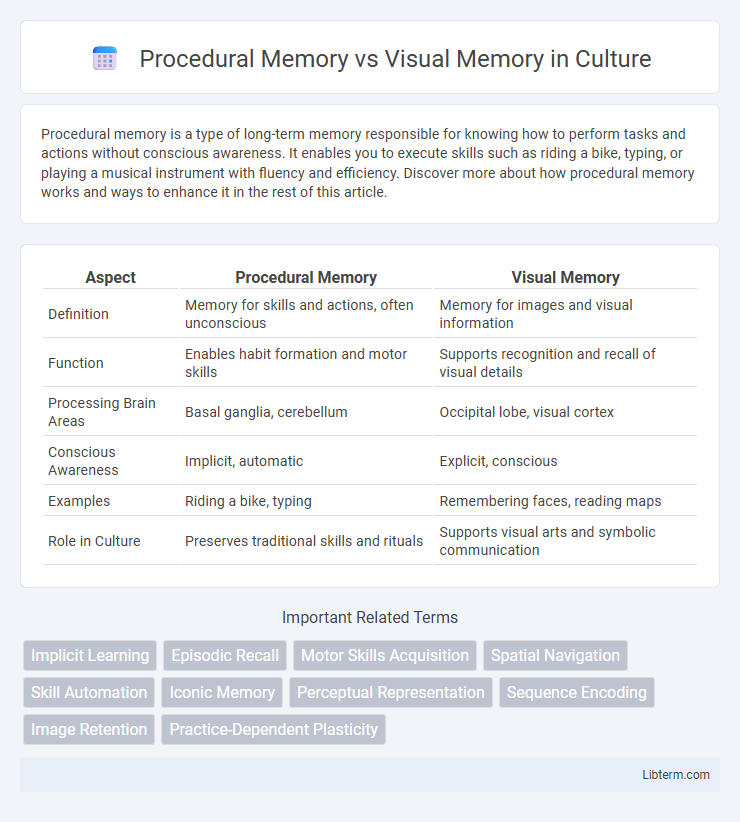Procedural memory is a type of long-term memory responsible for knowing how to perform tasks and actions without conscious awareness. It enables you to execute skills such as riding a bike, typing, or playing a musical instrument with fluency and efficiency. Discover more about how procedural memory works and ways to enhance it in the rest of this article.
Table of Comparison
| Aspect | Procedural Memory | Visual Memory |
|---|---|---|
| Definition | Memory for skills and actions, often unconscious | Memory for images and visual information |
| Function | Enables habit formation and motor skills | Supports recognition and recall of visual details |
| Processing Brain Areas | Basal ganglia, cerebellum | Occipital lobe, visual cortex |
| Conscious Awareness | Implicit, automatic | Explicit, conscious |
| Examples | Riding a bike, typing | Remembering faces, reading maps |
| Role in Culture | Preserves traditional skills and rituals | Supports visual arts and symbolic communication |
Understanding Procedural Memory
Procedural memory involves the unconscious retention of skills and actions, enabling tasks like riding a bike or typing without conscious thought. It is primarily associated with the basal ganglia and cerebellum, essential brain structures for motor control and habit formation. This type of memory contrasts with visual memory, which stores visual information consciously for recognition and recall of images or spatial relationships.
Exploring Visual Memory
Visual memory enables the brain to store and recall images, patterns, and spatial information, playing a crucial role in activities like navigation and object recognition. Unlike procedural memory, which governs skills and motor tasks, visual memory involves the encoding, storage, and retrieval of visual stimuli through areas such as the occipital lobe and the hippocampus. Enhancing visual memory can improve learning efficiency in subjects requiring strong visual-spatial skills, including art, mathematics, and engineering.
Key Differences Between Procedural and Visual Memory
Procedural memory involves the unconscious recall of skills and actions, such as riding a bike or typing, while visual memory pertains to the ability to remember and recall visual information like shapes, colors, and spatial arrangements. Procedural memory operates through motor sequences and habits encoded in the basal ganglia and cerebellum, contrasting with visual memory that primarily engages the occipital and parietal lobes of the brain responsible for processing and retaining visual stimuli. Key differences lie in the nature of information stored--procedural memory is implicit and action-oriented, whereas visual memory is explicit and detail-oriented.
How Procedural Memory Works
Procedural memory operates through the basal ganglia and cerebellum, enabling the unconscious acquisition and execution of motor skills and habits such as riding a bike or typing. It stores information on how to perform tasks without conscious awareness, often developed through repetition and practice over time. This type of memory contrasts with visual memory, which relies on the occipital lobe and is responsible for consciously recalling and recognizing visual information.
Mechanisms of Visual Memory
Visual memory relies primarily on the functioning of the occipital lobe and the ventral stream, which process and store visual information through encoding, consolidation, and retrieval stages. Specialized neural circuits in the hippocampus and parietal cortex support the integration and spatial mapping of visual stimuli, enabling detailed image reconstruction and recognition. These mechanisms contrast with procedural memory, which depends on the basal ganglia and cerebellum for the unconscious learning and execution of motor skills.
Real-life Examples: Procedural vs Visual Memory
Procedural memory enables tasks like riding a bicycle or typing without conscious thought, reflecting motor skills learned through repetition. Visual memory is essential for recalling faces, navigating environments, or remembering visual details such as a street map or a painting. Real-life use of procedural memory includes driving a car, while visual memory supports activities like recognizing landmarks during travel.
Brain Regions Involved in Each Memory Type
Procedural memory primarily involves the basal ganglia, cerebellum, and motor cortex, which are critical for the learning and execution of motor skills and habits. Visual memory mainly engages the occipital lobe, particularly the primary visual cortex, along with the parietal lobe and hippocampus for processing and storing visual information. Distinct neural circuits underline procedural memory's role in skill automation, while visual memory relies on regions responsible for perception and spatial processing.
Impact on Learning and Skill Development
Procedural memory, responsible for storing motor skills and habits, profoundly impacts skill acquisition by enabling automatic execution of tasks through repetition, which enhances efficiency and accuracy over time. Visual memory supports learning by allowing the retention and recall of visual information, facilitating pattern recognition and spatial understanding essential for problem-solving and creativity. Together, these memory systems complement each other: procedural memory solidifies physical skills while visual memory aids cognitive processing, both crucial for comprehensive learning and skill development.
Disorders Affecting Procedural and Visual Memory
Disorders affecting procedural memory include Parkinson's disease and Huntington's disease, which impair motor skills and habit formation through basal ganglia dysfunction. Visual memory deficits often arise in conditions such as Alzheimer's disease and posterior cortical atrophy, leading to difficulty in recognizing and recalling visual information. Damage to specific brain regions like the hippocampus and occipital lobe underlies these impairments, disrupting the encoding and retrieval of procedural and visual memories respectively.
Improving and Training Memory Skills
Procedural memory strengthens through repetitive practice of tasks like playing an instrument or riding a bike, enhancing automatic skill performance without conscious effort. Visual memory improves by engaging in activities that require recalling images, patterns, or spatial relationships, such as puzzle-solving or memory games involving picture sequences. Consistent training using targeted exercises boosts neural pathways associated with both procedural and visual memory, leading to faster recall and better retention of learned information.
Procedural Memory Infographic

 libterm.com
libterm.com